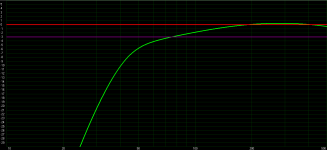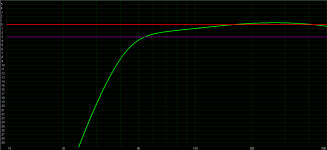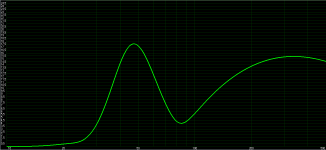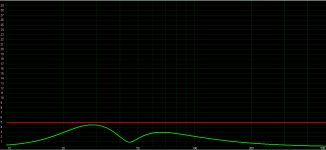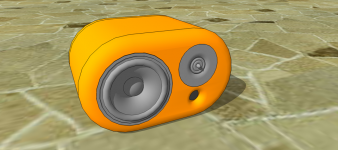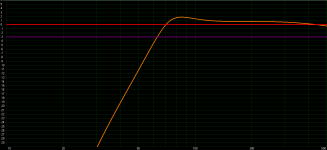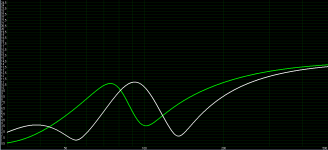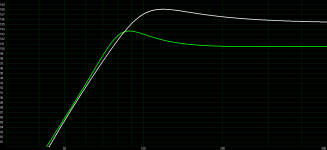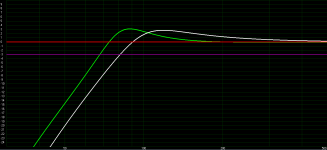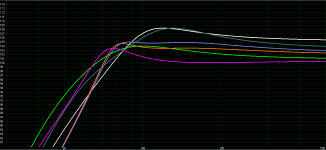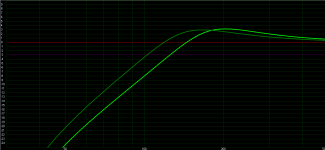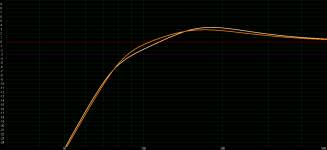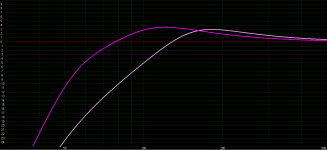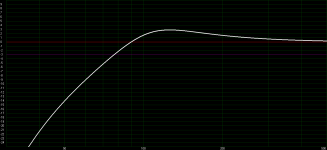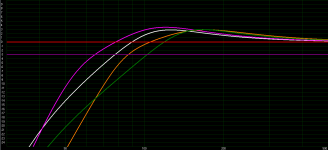Hello everybody! I am new here, have been reading for a while now. Next to the reading I have also been designing and now I think it is time to get my design and plans validated by some more experienced builders.
I am new to speaker building. The project I am working on is a portable speaker and is my first. This subject has been discussed plenty on these forums and more than once I stumbled upon the term "boominator". I do not intent to make my own boominator, it will be a design of my own with which I need some help from you!
The idea:
Let me start by showing the design, to make the idea clear from the start:
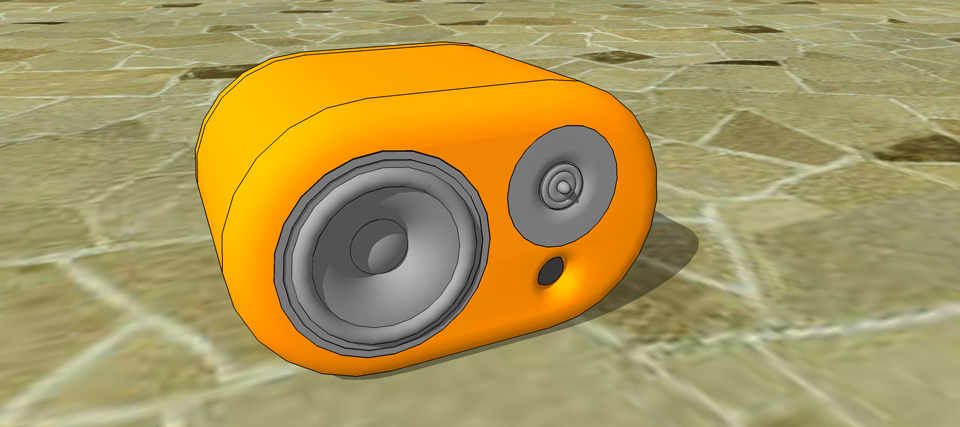
This is a sketchup model of how I would like to build the two-way. Dimensions are WxHxD 40cm x 20cm x 25cm (16"x8"x10"). Internal volume around 10L (0.35ft3).
The idea behind this design is a small lightweight portable speaker that is loud enough for a small group (max 20 people) to listen to some music, both relaxed music and some heavy bass electronic music. Although some might think this application does not need a hifi-ish approach, I enjoy doing things properly and that is why I try to make a properly designed speaker.
Now of course the challenges are to combine efficiency with portability and bass...
The components:
Box: birch plywood (12 or 18mm, 1/2" and 7/10")
Woofer: Silver Flute W17RC38-4ohm (link)
Tweeter: Vifa XT25BG60-4ohm (link)
Amplifier: MaxAmp20 Class-D (link)
Filter and crossover: MiniDSP + UMIK-1 (link)
The design:
Since I do not have any experience in filter and crossover circuits, I think it is wise to do this with a DSP, the miniDSP in this case. This solution allows me to quickly measure and change the crossover/filters. On this forum I have read more than once about the difficulties in proper crossover design for beginners.
The woofer is selected based on very positive reviews, also on these forums, paired with reasonable efficiency and low Qts and Vas. Below you can find a plot from WinISD. The woofer can reach quite low although the box is fairly small, 10L (0.35ft3) tuned to 45Hz. As you can see in the plot, the response is not flat. I do this to let it run a bit further down allowing me to raise it a little bit with the miniDSP. Now the f3 is around 70Hz but with a filter it should easily reach 50Hz, as can be seen from the second plot where I applied a parEQ 50Hz, Q=0.8 and gain=2dB.
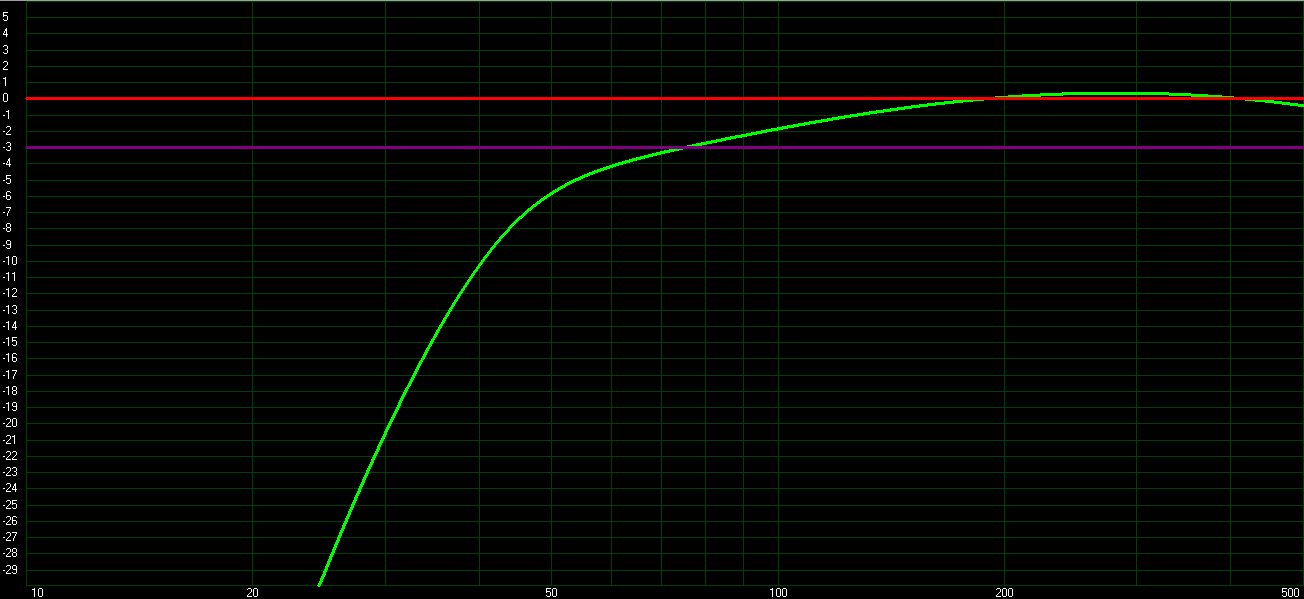
Response with highpass @ 25Hz

Response with highpass @ 25Hz and parEQ @ 50Hz (Q=0.8, gain=2dB)
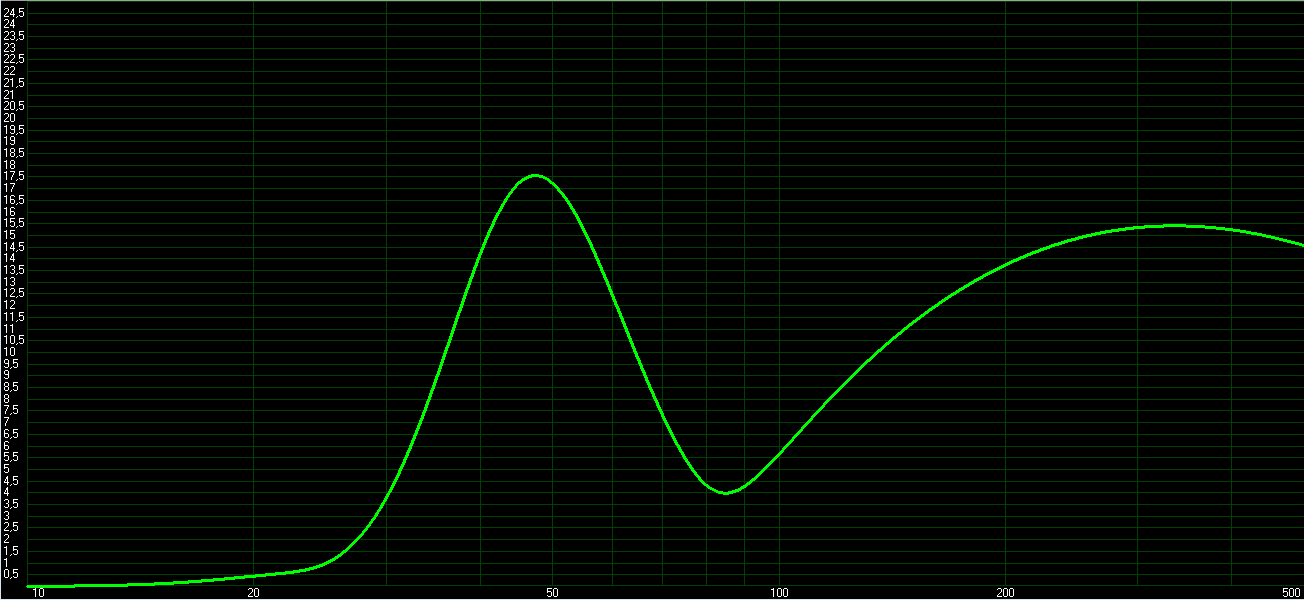
Amplifier apparent load with parEQ
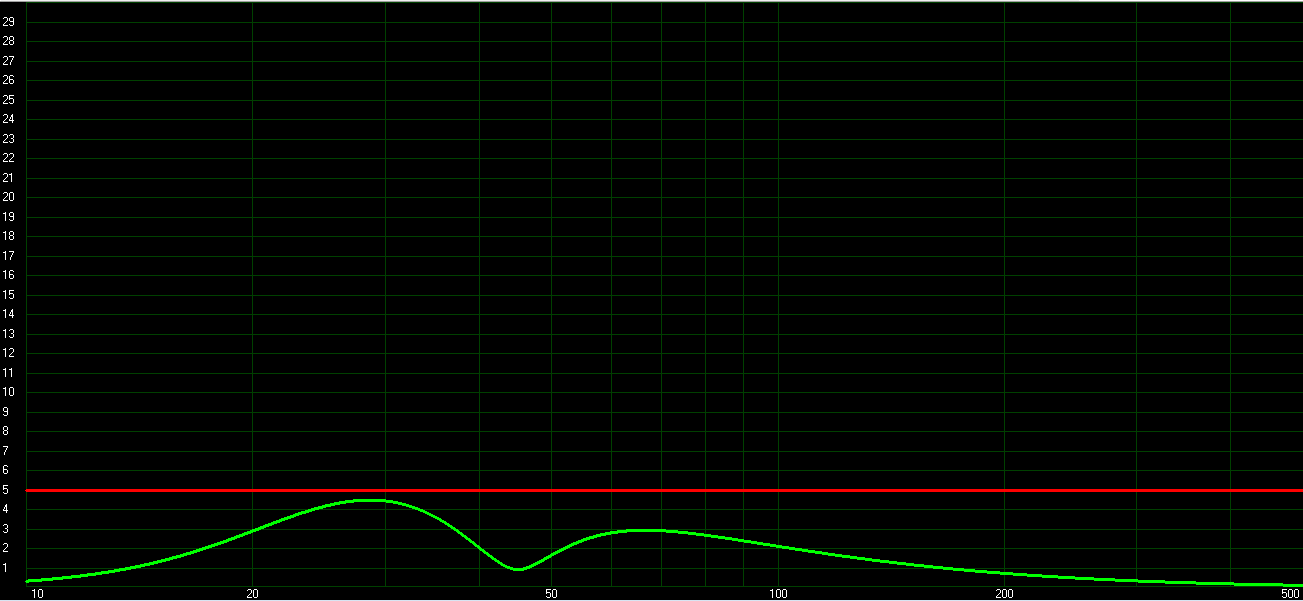
Cone excursion with parEQ
Since I am using a low power amplifier with:
full battery: 14W (1% THD), 18W (10% THD)
Empty battery: 10W (1% THD), 13W (10% THD)
I wonder if the higher apparent load due to the filter is going to cause problems. Or is this only related to passive filtering and is the effect different when I filter via the miniDSP?
The port is on the front since the speaker will be played outside and I do not want a part of the sound pressure to be radiated to the back. The drivers are mounted flush on the front panel to reduce diffraction. To further optimize this, the edges are rounded with a 3cm (1 1/6") radius and the tweeter is mounted asymmetrical.
I want the crossover low to allow the woofer to play low with ease. I hope it is possible to put it at 1800Hz but that might be a little low. Else I will shift it up towards 2500Hz. Advantage is that the miniDSP allows for very steep crossovers. The tweeter level might need some adjusting but this is not a problem with the DSP.
The stereo signal from for example a phone will be transformed to mono by using a simple passive summing circuit (link). This mono signal will go through the miniDSP which deals with the crossover and filters/gains. Two outputs will go to the 2ch. amplifier which powers the drivers.
I am anxious to hear what you think of my idea/design! Are there any concerns about hardware selection? Are there important factors I have not taken into account?
I am new to speaker building. The project I am working on is a portable speaker and is my first. This subject has been discussed plenty on these forums and more than once I stumbled upon the term "boominator". I do not intent to make my own boominator, it will be a design of my own with which I need some help from you!
The idea:
Let me start by showing the design, to make the idea clear from the start:
This is a sketchup model of how I would like to build the two-way. Dimensions are WxHxD 40cm x 20cm x 25cm (16"x8"x10"). Internal volume around 10L (0.35ft3).
The idea behind this design is a small lightweight portable speaker that is loud enough for a small group (max 20 people) to listen to some music, both relaxed music and some heavy bass electronic music. Although some might think this application does not need a hifi-ish approach, I enjoy doing things properly and that is why I try to make a properly designed speaker.
Now of course the challenges are to combine efficiency with portability and bass...
The components:
Box: birch plywood (12 or 18mm, 1/2" and 7/10")
Woofer: Silver Flute W17RC38-4ohm (link)
Tweeter: Vifa XT25BG60-4ohm (link)
Amplifier: MaxAmp20 Class-D (link)
Filter and crossover: MiniDSP + UMIK-1 (link)
The design:
Since I do not have any experience in filter and crossover circuits, I think it is wise to do this with a DSP, the miniDSP in this case. This solution allows me to quickly measure and change the crossover/filters. On this forum I have read more than once about the difficulties in proper crossover design for beginners.
The woofer is selected based on very positive reviews, also on these forums, paired with reasonable efficiency and low Qts and Vas. Below you can find a plot from WinISD. The woofer can reach quite low although the box is fairly small, 10L (0.35ft3) tuned to 45Hz. As you can see in the plot, the response is not flat. I do this to let it run a bit further down allowing me to raise it a little bit with the miniDSP. Now the f3 is around 70Hz but with a filter it should easily reach 50Hz, as can be seen from the second plot where I applied a parEQ 50Hz, Q=0.8 and gain=2dB.
Response with highpass @ 25Hz
Response with highpass @ 25Hz and parEQ @ 50Hz (Q=0.8, gain=2dB)
Amplifier apparent load with parEQ
Cone excursion with parEQ
Since I am using a low power amplifier with:
full battery: 14W (1% THD), 18W (10% THD)
Empty battery: 10W (1% THD), 13W (10% THD)
I wonder if the higher apparent load due to the filter is going to cause problems. Or is this only related to passive filtering and is the effect different when I filter via the miniDSP?
The port is on the front since the speaker will be played outside and I do not want a part of the sound pressure to be radiated to the back. The drivers are mounted flush on the front panel to reduce diffraction. To further optimize this, the edges are rounded with a 3cm (1 1/6") radius and the tweeter is mounted asymmetrical.
I want the crossover low to allow the woofer to play low with ease. I hope it is possible to put it at 1800Hz but that might be a little low. Else I will shift it up towards 2500Hz. Advantage is that the miniDSP allows for very steep crossovers. The tweeter level might need some adjusting but this is not a problem with the DSP.
The stereo signal from for example a phone will be transformed to mono by using a simple passive summing circuit (link). This mono signal will go through the miniDSP which deals with the crossover and filters/gains. Two outputs will go to the 2ch. amplifier which powers the drivers.
I am anxious to hear what you think of my idea/design! Are there any concerns about hardware selection? Are there important factors I have not taken into account?
Attachments
Last edited:
Good point, the box is not easy to build. The roundover is large and routers that size are expensive. I was thinking of using three layers of plywood stacked and having a local woodworking company mill it down to the required radius. I should inquire about this!
The port is 3cm (1 1/6") in diameter so that it is not too long inside and so that I can make a nice rounded flare on the outside. Speed according to WinISD is 35m/s max.
The port is 3cm (1 1/6") in diameter so that it is not too long inside and so that I can make a nice rounded flare on the outside. Speed according to WinISD is 35m/s max.
I'd tune the port higher. You won't hear 50Hz from a 6" cone outside.
The Boominator (which I'd consider the reference for outdoor boombox design) uses a too-small cabinet, tuned quite high. The result is a bump in the response around 80-120Hz, with very little output below that. That bump will make the speaker hit you in the chest, whereas trying to get the same trick at 50Hz will need a lot of speakers and power.
IIRC, the tweeter you've chosen is very sturdy, and shouldn't have any problems going to 1800Hz. Be sure to keep the crossover steep though - I like 4th order Linkwitz Riley.
Chris
The Boominator (which I'd consider the reference for outdoor boombox design) uses a too-small cabinet, tuned quite high. The result is a bump in the response around 80-120Hz, with very little output below that. That bump will make the speaker hit you in the chest, whereas trying to get the same trick at 50Hz will need a lot of speakers and power.
IIRC, the tweeter you've chosen is very sturdy, and shouldn't have any problems going to 1800Hz. Be sure to keep the crossover steep though - I like 4th order Linkwitz Riley.
Chris
Thank you for the confirmation about the tweeter!
Could you possibly elaborate on the advantages of a bump at 80Hz compared to a slightly sloping response to 50Hz? I get the way it works I am just trying to figure out why the first option is better.
I've read about this in the boominator thread as well, what exactly is the reason behind choosing the bump if you play in free field? Does it have something to do with the baffle step which reduces the bass in free field more than in a room since there are no reflections?
Could you possibly elaborate on the advantages of a bump at 80Hz compared to a slightly sloping response to 50Hz? I get the way it works I am just trying to figure out why the first option is better.
I've read about this in the boominator thread as well, what exactly is the reason behind choosing the bump if you play in free field? Does it have something to do with the baffle step which reduces the bass in free field more than in a room since there are no reflections?
For an outdoors/party type speaker I'm a bit worried about that tweeter with its protruding phase plug nipple. Seems it might easily be damaged.
I'd go for a tweeter with a more recessed dome like these:
http://www.scan-speak.dk/datasheet/pdf/d2606-922000.pdf
http://www.tymphany.com/files/D27TG-35-06 Rev1_0.pdf
Or use a waveguide.
PS: While googling these I noticed that according to the heading in google Tymphany is the manufacturer of Scan-Peek (sic) drivers!
I'd go for a tweeter with a more recessed dome like these:
http://www.scan-speak.dk/datasheet/pdf/d2606-922000.pdf
http://www.tymphany.com/files/D27TG-35-06 Rev1_0.pdf
Or use a waveguide.
PS: While googling these I noticed that according to the heading in google Tymphany is the manufacturer of Scan-Peek (sic) drivers!
The bump in the bass response, as well as upping your maximum SPL, has a psychological effect: a bump ~100Hz will make a speaker system sound (to the untrained ear) like there's plenty of bass, when in fact there is no "real" bass present. These little portable wireless speakers do much the same thing, making a fairly hefty sound from a couple of 2" drivers.
Indoors, a sloping response to 50Hz would be quite listenable, as you get boundry gain and room pressure mode to boost those frequencies, giving (in room) a ~flat response to 50Hz.
Outdoors, its an entirely different game: forget about going low, just make what the woofer can do as loud as possible (or at least, audible). I'd aim for 80Hz with a 6" - I'm using a couple of 8"s to go to 63Hz (-3dB point). In a "normal" ported alignment they'd hit around 35Hz.
Its very hard to explain the effect, but it definitely does work, and you can try it quite easily:
When you build your speaker, get one of those ports where you can change the length (and therefore the tuning) and see what happens to the sound when you're outdoors. I'd bet you go for a higher tuning than 50Hz
Chris
Indoors, a sloping response to 50Hz would be quite listenable, as you get boundry gain and room pressure mode to boost those frequencies, giving (in room) a ~flat response to 50Hz.
Outdoors, its an entirely different game: forget about going low, just make what the woofer can do as loud as possible (or at least, audible). I'd aim for 80Hz with a 6" - I'm using a couple of 8"s to go to 63Hz (-3dB point). In a "normal" ported alignment they'd hit around 35Hz.
Its very hard to explain the effect, but it definitely does work, and you can try it quite easily:
When you build your speaker, get one of those ports where you can change the length (and therefore the tuning) and see what happens to the sound when you're outdoors. I'd bet you go for a higher tuning than 50Hz
Chris
Thanks Chris, that's a very good explanation. And you are right, I can easily test this when I have all the materials. Here is the plot for a 10L box with tuning at 70Hz. Is something like this okay? I can also tune it to 93Hz and I would get a 6dB bump around 100Hz and an f3 slightly below 80Hz.

Now you also made a fair point about this: "just make what the woofer can do as loud as possible"
The woofers I am using right now are in my opinion quite good. They allow a small cabinet size and offer decent sensitivity. However, comparing them to the 10" boominator PA woofers, they are a bit of a let down.
Current woofer is 4ohm with sensitivity of 89db (1W/1m) and with 14W I can achieve SPL of 101dB at 1m.
The PA woofers usually are 8ohm and 96dB (1W/1m) and would go quite a bit louder. Difference would be even bigger if two of these are used in parallel for a 4ohm combined load.
The problem is that there is no step between, using two 10" woofers greatly increases the size and decreases the portability. Are my woofers a solid choice nevertheless?
Also, since I am not using woofers on both sides, I will lose some bass response due to baffle step. Is this something I should take into account or is it easily fixed by using the miniDSP?
Now you also made a fair point about this: "just make what the woofer can do as loud as possible"
The woofers I am using right now are in my opinion quite good. They allow a small cabinet size and offer decent sensitivity. However, comparing them to the 10" boominator PA woofers, they are a bit of a let down.
Current woofer is 4ohm with sensitivity of 89db (1W/1m) and with 14W I can achieve SPL of 101dB at 1m.
The PA woofers usually are 8ohm and 96dB (1W/1m) and would go quite a bit louder. Difference would be even bigger if two of these are used in parallel for a 4ohm combined load.
The problem is that there is no step between, using two 10" woofers greatly increases the size and decreases the portability. Are my woofers a solid choice nevertheless?
Also, since I am not using woofers on both sides, I will lose some bass response due to baffle step. Is this something I should take into account or is it easily fixed by using the miniDSP?
Attachments
Last edited:
Since I cannot seem to edit my previous post, i made a new one. I made a quick comparison between the 6.5" silver flute and the 8" faital 8FE200 (link)
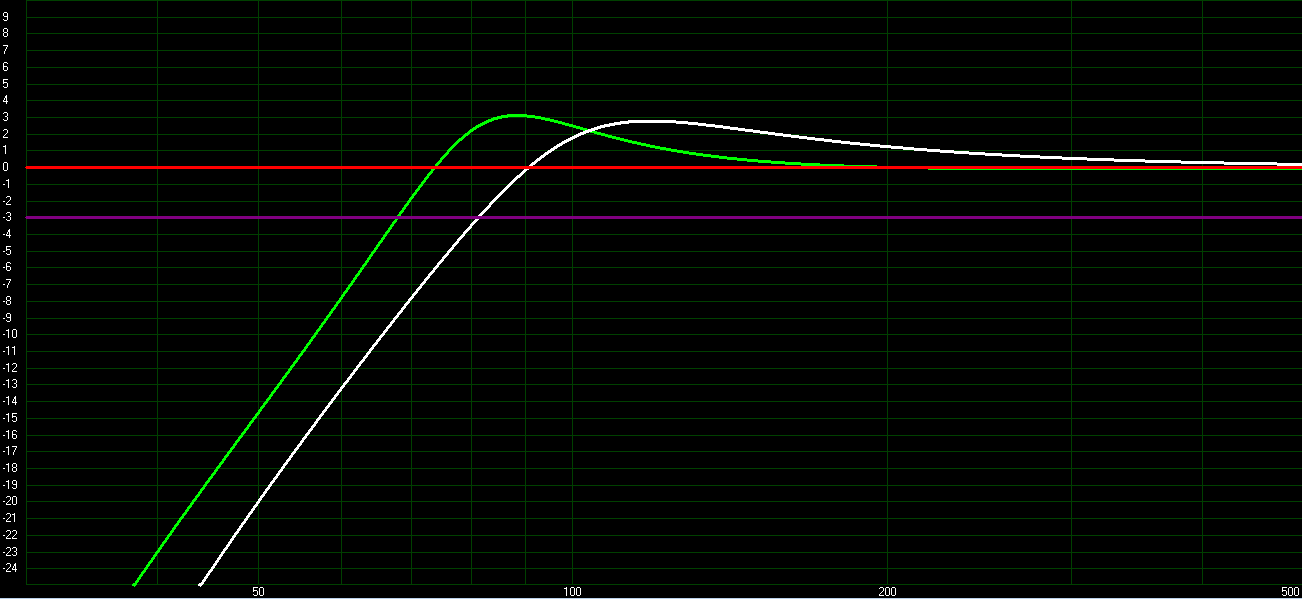
Response

SPL
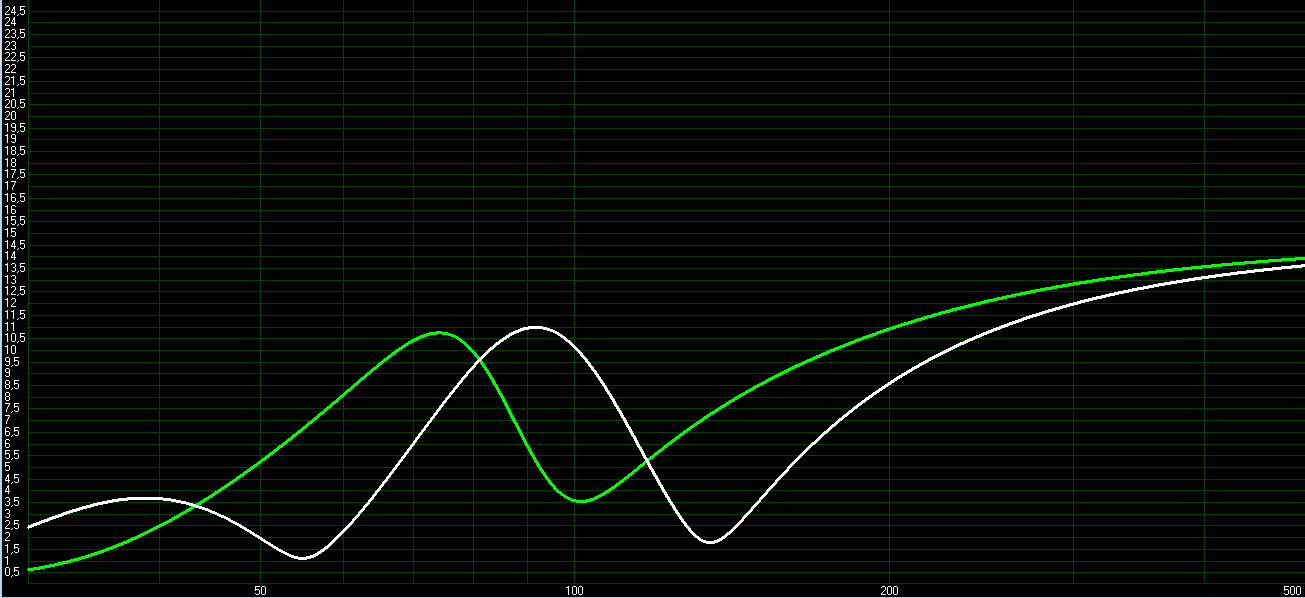
Power
Response
SPL
Power
Attachments
The 8" woofer is looking promising. I'd say if you already have the 6"s, then save your money and use them, but if the costs are about equal, go with the 8".
The 70Hz tuning with the 6" is about the right shape response you're shooting for. The higher sensitivity 8" takes the f3 up a bit, but you'll gain an awful lot of battery life or SPL.
It might be worth trying some drivers part-way between the two you've tried so far: FaitalPRO | LF Loudspeakers | 6FE100
I know it's 8ohm, but I think you get the idea. That one might go in a really small box, so you could go bipole like the Boominator, but I'll let you run some simulations on that.
Things to remember when choosing the maximum SPL you want...
1 - assume ~10dB dynamic range, so take your maximum SPL, then subtract 10dB from it. That's your average volume level.
2 - check the equal loudness contours, make sure you're not going too low. If I have a system that'll do 80dB peaks, flat to 20Hz, the 20Hz won't be heard, so there's no point going so low. Keep the equal loudness contours handy as a sanity check.
Now you've taken up the bumped response, #2 probably won't be an issue.
FWIW, my boombox (pair of 8"ers, plus a pair of KEF 3" coaxials, 4x 15w of amplifiers) will hit somewhere around 107dB peaks, and I'd consider this adequate. With the high-efficiency 8", you won't be far behind.
Check your cone excursion and do some Googling about how low your tweeter can be used at decent power levels. I'd expect it to be fine, but you might end up dealing with fairly severe cone break-up on that PA 8".
HTH
Chris
The 70Hz tuning with the 6" is about the right shape response you're shooting for. The higher sensitivity 8" takes the f3 up a bit, but you'll gain an awful lot of battery life or SPL.
It might be worth trying some drivers part-way between the two you've tried so far: FaitalPRO | LF Loudspeakers | 6FE100
I know it's 8ohm, but I think you get the idea. That one might go in a really small box, so you could go bipole like the Boominator, but I'll let you run some simulations on that.
Things to remember when choosing the maximum SPL you want...
1 - assume ~10dB dynamic range, so take your maximum SPL, then subtract 10dB from it. That's your average volume level.
2 - check the equal loudness contours, make sure you're not going too low. If I have a system that'll do 80dB peaks, flat to 20Hz, the 20Hz won't be heard, so there's no point going so low. Keep the equal loudness contours handy as a sanity check.
Now you've taken up the bumped response, #2 probably won't be an issue.
FWIW, my boombox (pair of 8"ers, plus a pair of KEF 3" coaxials, 4x 15w of amplifiers) will hit somewhere around 107dB peaks, and I'd consider this adequate. With the high-efficiency 8", you won't be far behind.
Check your cone excursion and do some Googling about how low your tweeter can be used at decent power levels. I'd expect it to be fine, but you might end up dealing with fairly severe cone break-up on that PA 8".
HTH
Chris
Boominator MINI (development thread) - Speakerplans.com Forums - Page 20
Skip to page 20 for the latest and most relevant updates if don't feel like reading the whole thing.
Skip to page 20 for the latest and most relevant updates if don't feel like reading the whole thing.
@Chris661
I plotted the silver flute against the faitals
turqoise: Faital PRO 8FE200 8ohm
white: Faital PRO 8FE200 4ohm
green: Faital PRO 6FE100 8ohm
orange: Faital PRO 6FE200 8ohm
blue: Faital PRO 6FE200 4ohm
purple: Silver flute W17RC38 4ohm
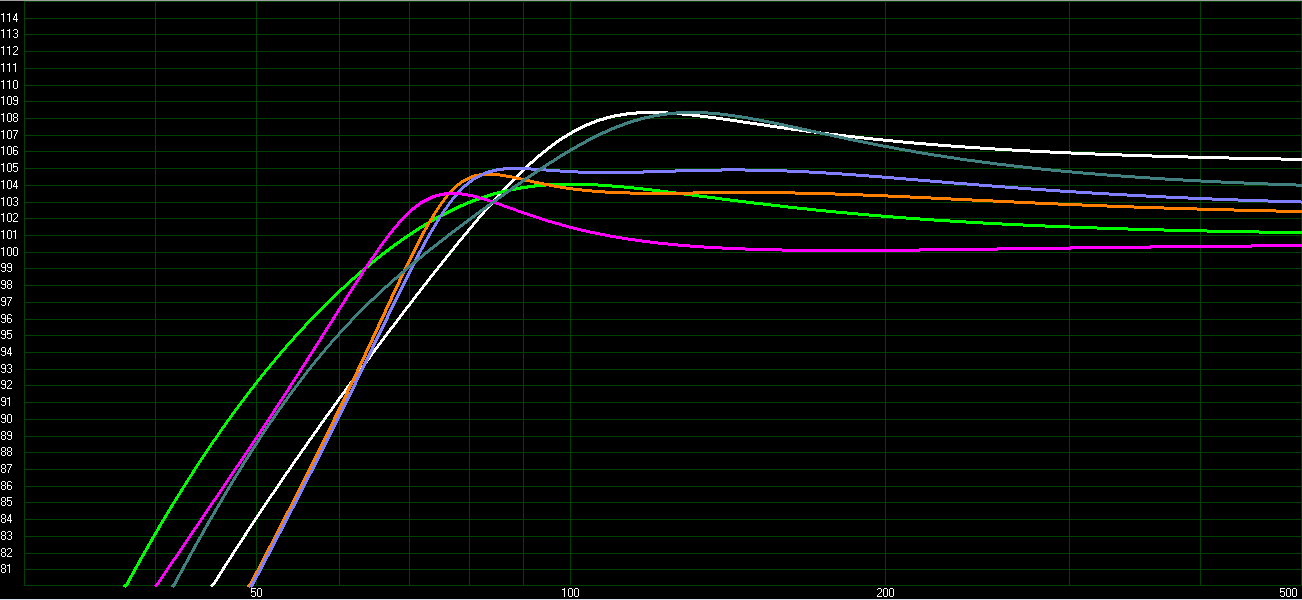
I plotted the silver flute against the faitals
turqoise: Faital PRO 8FE200 8ohm
white: Faital PRO 8FE200 4ohm
green: Faital PRO 6FE100 8ohm
orange: Faital PRO 6FE200 8ohm
blue: Faital PRO 6FE200 4ohm
purple: Silver flute W17RC38 4ohm
Attachments
woytek. The way you make a correct tuning is to use winISD online.
Take the resulting Vb and Fb from "optimum" there, and calculate the correct values by:
Vb(new) = Vb / Pi
Fb(new) = Fb * sqrt(2)
Plot the resulting new Vb and Fb into your calc software, and voila! you have the correct tuning.
If the resulting F0 (where it crosses the 0dB line again) is above 100hz. The driver is probably not suited for portable use.
Take the resulting Vb and Fb from "optimum" there, and calculate the correct values by:
Vb(new) = Vb / Pi
Fb(new) = Fb * sqrt(2)
Plot the resulting new Vb and Fb into your calc software, and voila! you have the correct tuning.
If the resulting F0 (where it crosses the 0dB line again) is above 100hz. The driver is probably not suited for portable use.
Last edited:
Thanks Saturnus, I read that indeed. This plot is just to try and compare the drivers though. They all have the same 14L Vb and Fb is quickly adjusted so they all have a 3dB peak. Roughly speaking!
I like the response of the silver flute a lot but there is no denying the extra SPL from a PA woofer. It's a difficult choice but there is one thing that I never considered or heard of: the equal loudness contours. This basically is the reasoning why a bumped response with high f3 is better than a flat/drooping response with low f3.
Based on this I would say the Faital Pro 8FE200 is a very good driver. Saturnus, I read that you also considered this driver but it didn't quite fit your boominator demands. Can you explain why? It looks to perform very well.
Now I am still wondering if I want to go single 4ohm driver or parallel 8 ohm driver for +3dB sensitivity.
Another question for saturnus: I have read the mini development thread and a lot of the big boominator thread. You mentioned a few times that active filters or crossovers are better with some drivers. Can you give me any reasons what I would gain with my MiniDSP? Efficiency? I am thinking that a high pass filter on the woofer will reduce cone excursion. Low pass on the woofer might give some additional headroom at lower frequencies?
I like the response of the silver flute a lot but there is no denying the extra SPL from a PA woofer. It's a difficult choice but there is one thing that I never considered or heard of: the equal loudness contours. This basically is the reasoning why a bumped response with high f3 is better than a flat/drooping response with low f3.
Based on this I would say the Faital Pro 8FE200 is a very good driver. Saturnus, I read that you also considered this driver but it didn't quite fit your boominator demands. Can you explain why? It looks to perform very well.
Now I am still wondering if I want to go single 4ohm driver or parallel 8 ohm driver for +3dB sensitivity.
Another question for saturnus: I have read the mini development thread and a lot of the big boominator thread. You mentioned a few times that active filters or crossovers are better with some drivers. Can you give me any reasons what I would gain with my MiniDSP? Efficiency? I am thinking that a high pass filter on the woofer will reduce cone excursion. Low pass on the woofer might give some additional headroom at lower frequencies?
Last edited:
Indeed efficiency but with for example miniDSP, you can take your boombox outside and place a measurement microphone in a typical listening position, and run the room eq wizard to get just about perfect frequency response.
Yes. The equal loudness contour cannot be ignored when you're designing for outdoors use. And Qbox of the speaker also appears (to a listener) to change completely. So much so that a particular Qbox outdoors appears to be about half the actual Qbox.
For monopole speakers, an even higher tuning Q might be relevant. The above is specifically for a bipole speaker that naturally have a +6dB lift at lower frequencies compared to a monopole speaker.
For small boom boxes bipolar does not have to mean a full stereo setup on both sides of the cabinet, it can also just be one channel on opposite sides.
I really can't remember the specific reason for all the hundreds of drivers that were considered but rejected for the Boominator. Maybe I should have noted down why they were rejected, but alas I only noted whether they could be used or not.
Yes. The equal loudness contour cannot be ignored when you're designing for outdoors use. And Qbox of the speaker also appears (to a listener) to change completely. So much so that a particular Qbox outdoors appears to be about half the actual Qbox.
For monopole speakers, an even higher tuning Q might be relevant. The above is specifically for a bipole speaker that naturally have a +6dB lift at lower frequencies compared to a monopole speaker.
For small boom boxes bipolar does not have to mean a full stereo setup on both sides of the cabinet, it can also just be one channel on opposite sides.
I really can't remember the specific reason for all the hundreds of drivers that were considered but rejected for the Boominator. Maybe I should have noted down why they were rejected, but alas I only noted whether they could be used or not.
That's clear thank you!
Indeed I ordered a microphone with my MiniDSP so I can measure and adjust the response easily. What you said in the last line about a mono setup with 2 woofers back to back is also what I am thinking of. This will increase efficiency and also removes the baffle step that I would have with a monopole setup. I guess this is what you mean with the +6dB with a dipole setup, since the baffle step is also 6dB loss.
About the Faitals, I understand you looked at so many drivers that you could never say why a particular one does not work. Maybe you could at least give me some tips what to look for? As I can see it now from the plots with the 8FE200 I get high sensitivity, low Vb, nice peak at required frequency for a reasonable price. I am wondering if I am missing something!
Indeed I ordered a microphone with my MiniDSP so I can measure and adjust the response easily. What you said in the last line about a mono setup with 2 woofers back to back is also what I am thinking of. This will increase efficiency and also removes the baffle step that I would have with a monopole setup. I guess this is what you mean with the +6dB with a dipole setup, since the baffle step is also 6dB loss.
About the Faitals, I understand you looked at so many drivers that you could never say why a particular one does not work. Maybe you could at least give me some tips what to look for? As I can see it now from the plots with the 8FE200 I get high sensitivity, low Vb, nice peak at required frequency for a reasonable price. I am wondering if I am missing something!
Check the high frequencies, make sure the upper range can be tamed reasonably easily.
If there's lots of peaks and dips in the kHz range, that indicates lots of resonances which will be audible even with a flat frequency response.
If that looks good, a single 8" 4ohm looks decent. Ideally, you'd go bipole, but the doubling of cabinet volume and significant weight increase might put you off.
Chris
If there's lots of peaks and dips in the kHz range, that indicates lots of resonances which will be audible even with a flat frequency response.
If that looks good, a single 8" 4ohm looks decent. Ideally, you'd go bipole, but the doubling of cabinet volume and significant weight increase might put you off.
Chris
@Saturnus, I plotted the "ideal" box for all the drivers. I used two drivers for the 8ohm speakers but for these plots this does not matter. It is clear from the other plots that there is a 6dB increase in maximum SPL.

light green: silver flute 4ohm
dark green: silver flute 8ohm
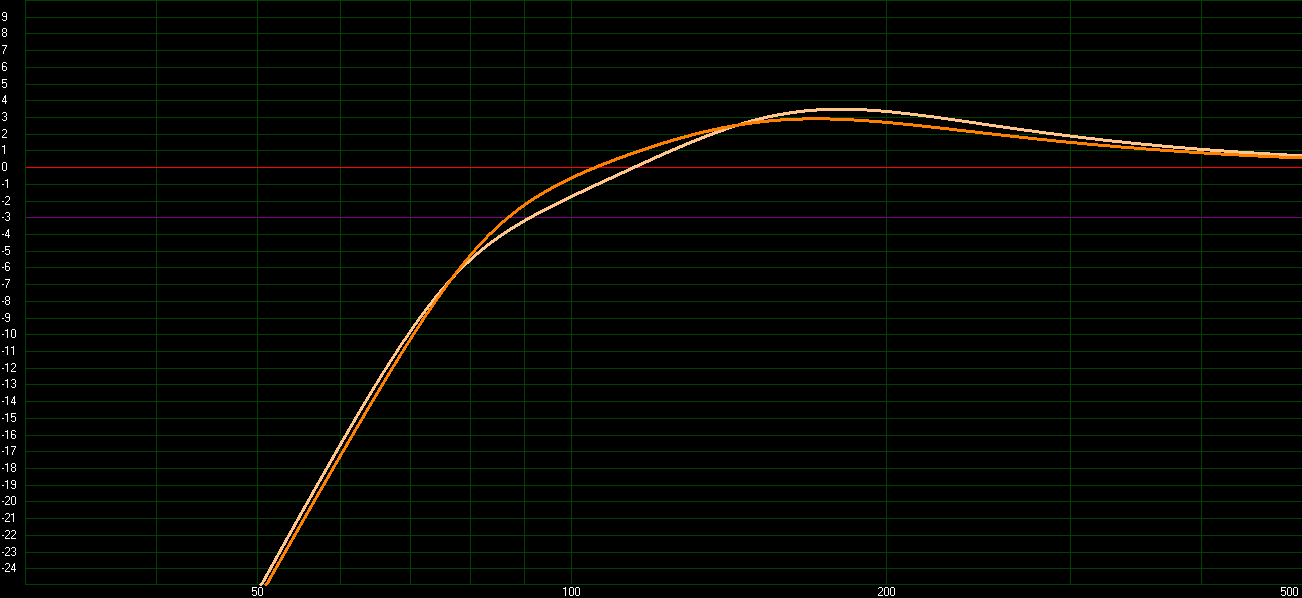
light orange: faital 6FE200 4
dark orange: faital 6FE200 8
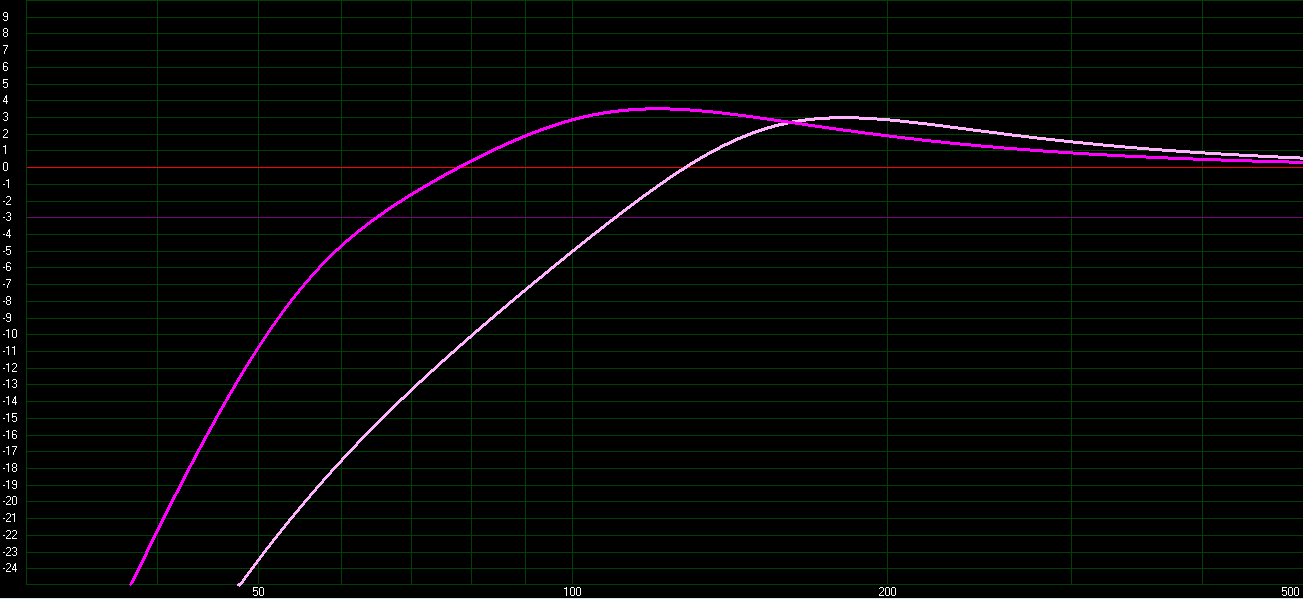
pink: faital 8FE200 4
purple: faital 8FE200 8
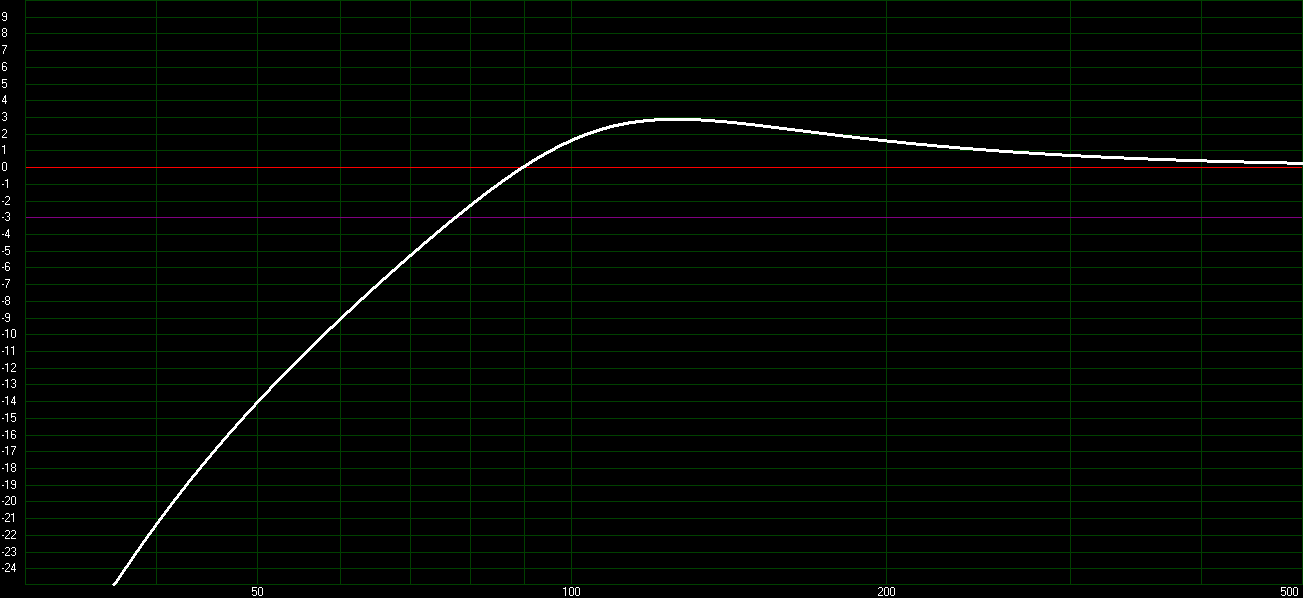
P.audio HP-10W
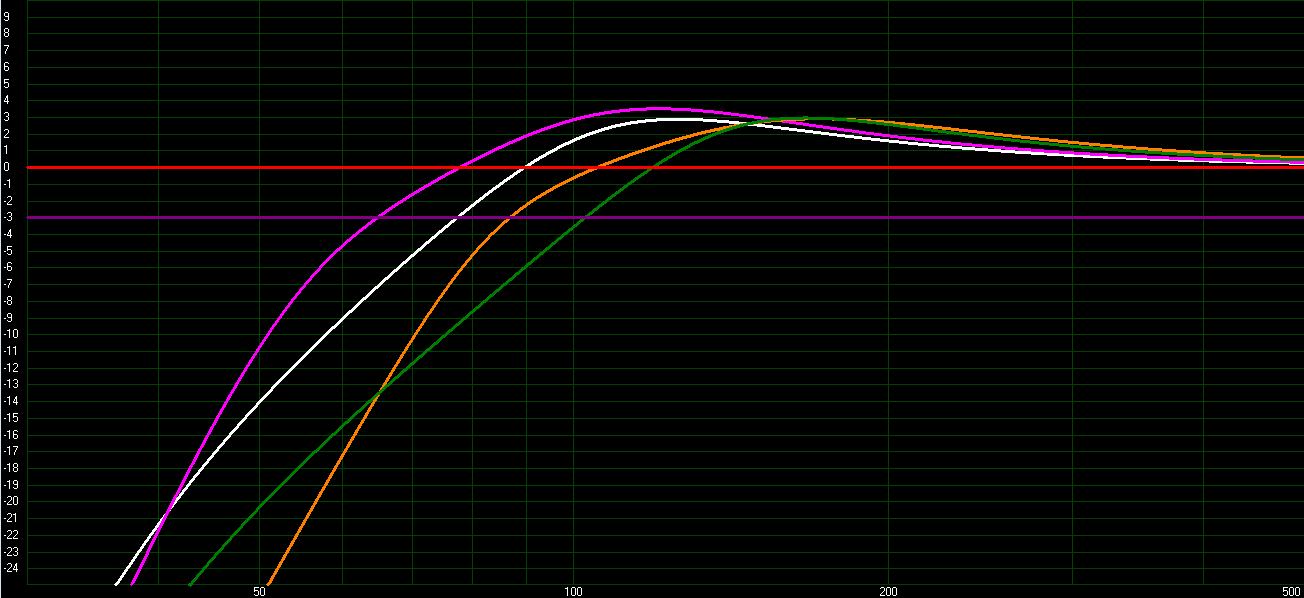
Plot of all double (8ohm) drivers
So I read what you said about the optimum Vb and Fb. I made the plots in winisd for the drivers I am currently looking at. I do not understand however why this size box is optimum. For example, by using a slightly larger box for the silver flutes I can get pretty much the same peak but at a lower frequency. I have not read anything in other threads why these rules you state about Vb and Fb should be the optimum. Also the definitions for Qtc do not help me with this. I would expect that if the response graphs are the same then it shouldn't matter what the Qbox is?
@Chris
I think all of the drivers are fine at least up till 2/3kHz at which point I would like the tweeter to take over anyway.
Regarding the 8FE200, it does look like a nice driver but according to saturnus' rules it is not very good compared to the others. I just need to figure out why!
By the way saturnus, anything you can share about the new amp you helped design or the new design for the MINI? I am interested in this:
light green: silver flute 4ohm
dark green: silver flute 8ohm
light orange: faital 6FE200 4
dark orange: faital 6FE200 8
pink: faital 8FE200 4
purple: faital 8FE200 8
P.audio HP-10W
Plot of all double (8ohm) drivers
So I read what you said about the optimum Vb and Fb. I made the plots in winisd for the drivers I am currently looking at. I do not understand however why this size box is optimum. For example, by using a slightly larger box for the silver flutes I can get pretty much the same peak but at a lower frequency. I have not read anything in other threads why these rules you state about Vb and Fb should be the optimum. Also the definitions for Qtc do not help me with this. I would expect that if the response graphs are the same then it shouldn't matter what the Qbox is?
@Chris
I think all of the drivers are fine at least up till 2/3kHz at which point I would like the tweeter to take over anyway.
Regarding the 8FE200, it does look like a nice driver but according to saturnus' rules it is not very good compared to the others. I just need to figure out why!
By the way saturnus, anything you can share about the new amp you helped design or the new design for the MINI? I am interested in this:
Since I am using active filtering through a miniDSP, how would this work in practice? Any way to calculate power required for certain filters?Most of it is done really. Sadly going this compact means you have to use a little electronic compensation, so for the "real version" we have to wait for the new amp to get enough power.
But it could be done now using the 4 ohms version of the faitals and 2 TA2021/24 amps with each channel driving their own speaker. That will nearly give enough power.
Attachments
Last edited:
- Status
- This old topic is closed. If you want to reopen this topic, contact a moderator using the "Report Post" button.
- Home
- Loudspeakers
- Multi-Way
- Advice requested for portable two way
